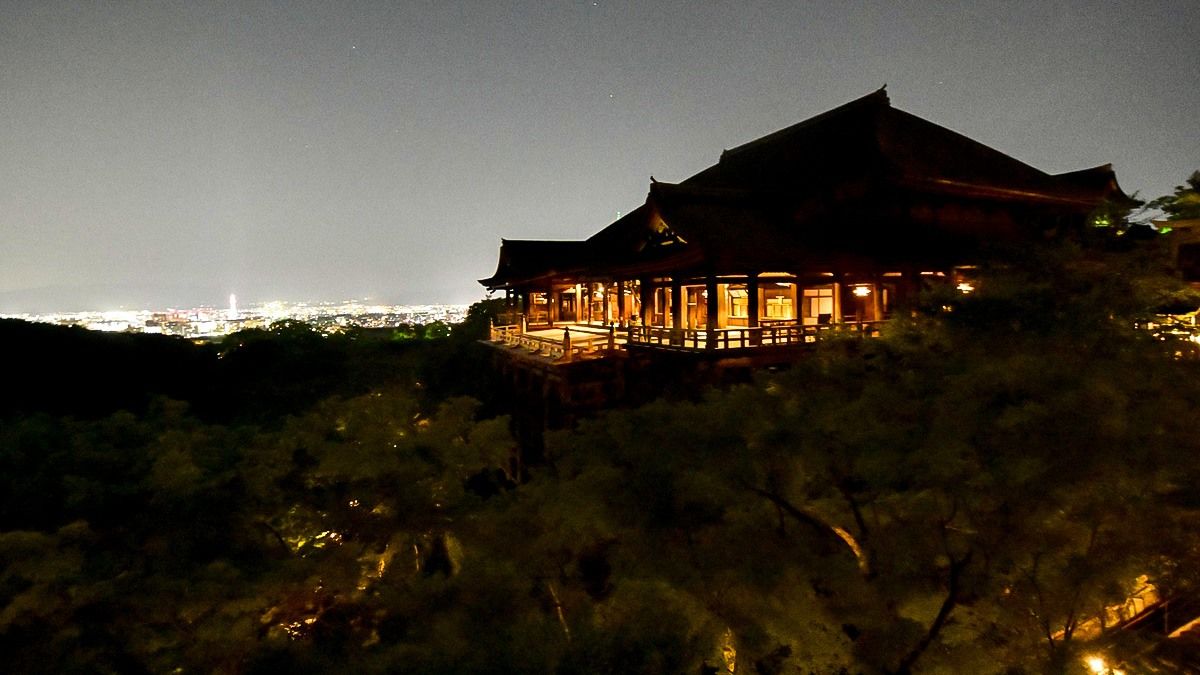
Kyoto and the Coronavirus: New Takes on Tourism in Japan’s Ancient Capital
Society Guide to Japan- English
- 日本語
- 简体字
- 繁體字
- Français
- Español
- العربية
- Русский
An End to Tourism?
Kyoto, the capital of Japan for centuries in ancient times, boasts history and tradition that are enormous draws for tourists from throughout Japan and all over the world. The city’s celebrated destinations in 2019 brought in a record 53 million visitors, with nearly 88 million coming to Kyoto Prefecture as a whole, representing a considerable portion of the local economy.
COVID-19 ended this all. As the virus spread early in 2020, domestic travelers put vacation plans on hold as part of voluntary restrictions on their movement, and international travel, whether for business or pleasure, became a thing of the past. The curtailing of foreign inbound tourism in particular has dealt a serious blow to Kyoto’s hotel industry, with overseas guests remaining at around 1% of pre-COVID levels as of May this year, according to the Kyoto Tourism Association.
In the early summer of 2021 I went to Kyoto to view the area’s sights and talk with travel industry operators and Buddhist temple representatives about how their city was faring in pandemic times. Everything has changed, was the answer; but they are changing as well, finding new ways to attract domestic visitors and exploring more sustainable ways of remaining relevant—efforts that remain important as Japan is in the throes of its seventh major wave of infections in the summer of 2022.
Heading Upstream
A comfortably empty Shinkansen delivers me to Kyoto Station, where I meet my companions, board the Arashiyama Line, and head west to JR Saga Arashiyama, the starting point for the Sagano Romantic Train Line, a torokko (diesel-powered trolley train) that climbs upstream along the winding Hozugawa to the city of Kameoka. The train is shockingly empty, with most of its elegant wood-appointed cars left closed and the few passengers scattered in one car, where the conductor can speak to us comfortably (and sing songs to us, at one point) about the sights we were seeing. The train stops at a particularly picturesque location to let riders photograph the river below. Arashiyama itself is famous for its bamboo groves, but the river valley offers different faces of beauty in each season; while we enjoyed the fresh greens of the beginning of summer, the autumn colors in ordinary years make it difficult to get a good window seat for this journey in that season.
Disembarking at Kameoka Torokko Station, we choose not to take the bus that whisks tourists to the riverboating center a short way upstream. Instead, we get tickets for a horse-drawn wagon that takes a winding dirt road to the same destination. The sturdy workhorse—a similar breed to those used in the Ban’ei races in Hokkaidō—takes his time, but during our 25 minutes in the wagon the road dips below the tall reeds in places, shutting out views of the construction cranes working on the Kameoka roads and leaving us with only the sound of clopping hooves and the nearby river, making it feel like a genuine trip to an earlier time.
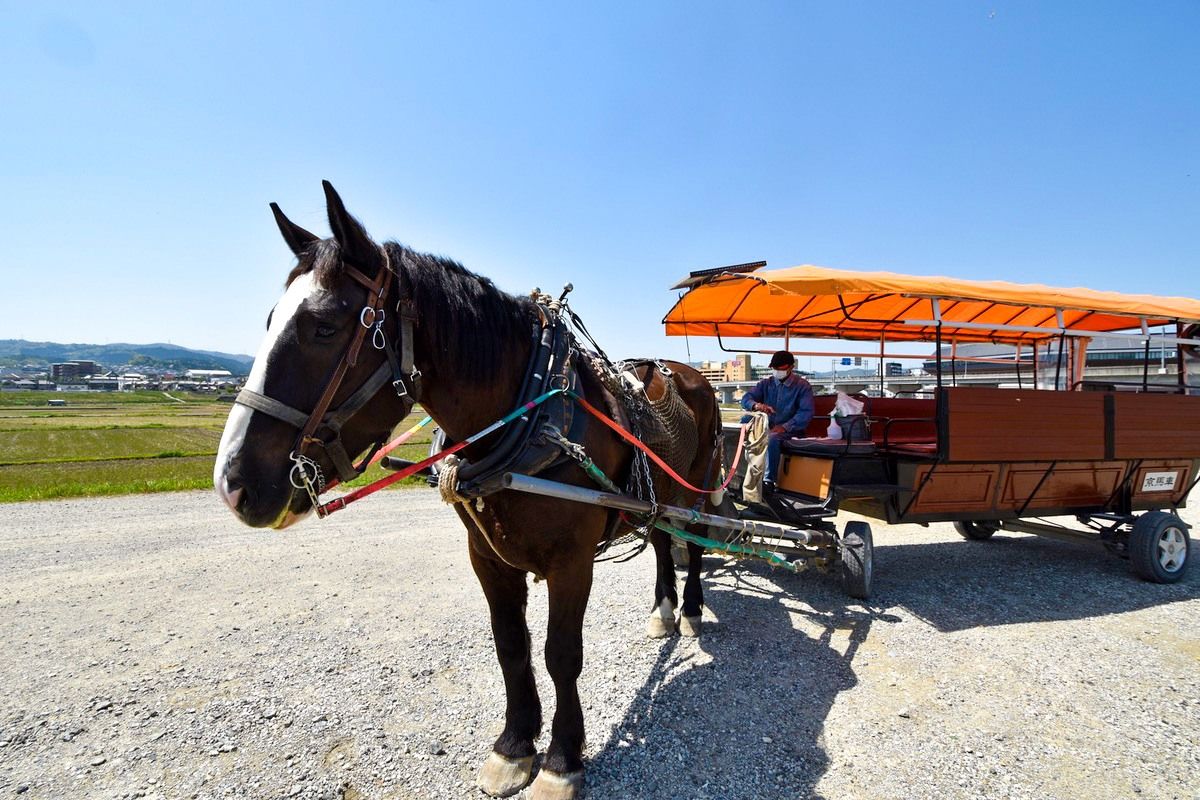
Agile, a five-year-old gelding, provides our ride to the boat launch. (© Nippon.com)
At the Kameoka boat landing we meet Toyota Tomoya, a river veteran who now serves as representative director of the Hozugawa River Boat Ride Association. Commercial boating on the Katsuragawa—the proper name for the longer river, which bears the Hozugawa name for only one of its stretches—has a history more than a dozen centuries old, he tells us. Kyoto suffered numerous major fires in its history, and each time required considerable amounts of lumber to rebuild. This was brought from forests in what is now the north of Kyoto Prefecture in the form of log rafts, tied into long trains and ridden downstream by skilled raftsmen.
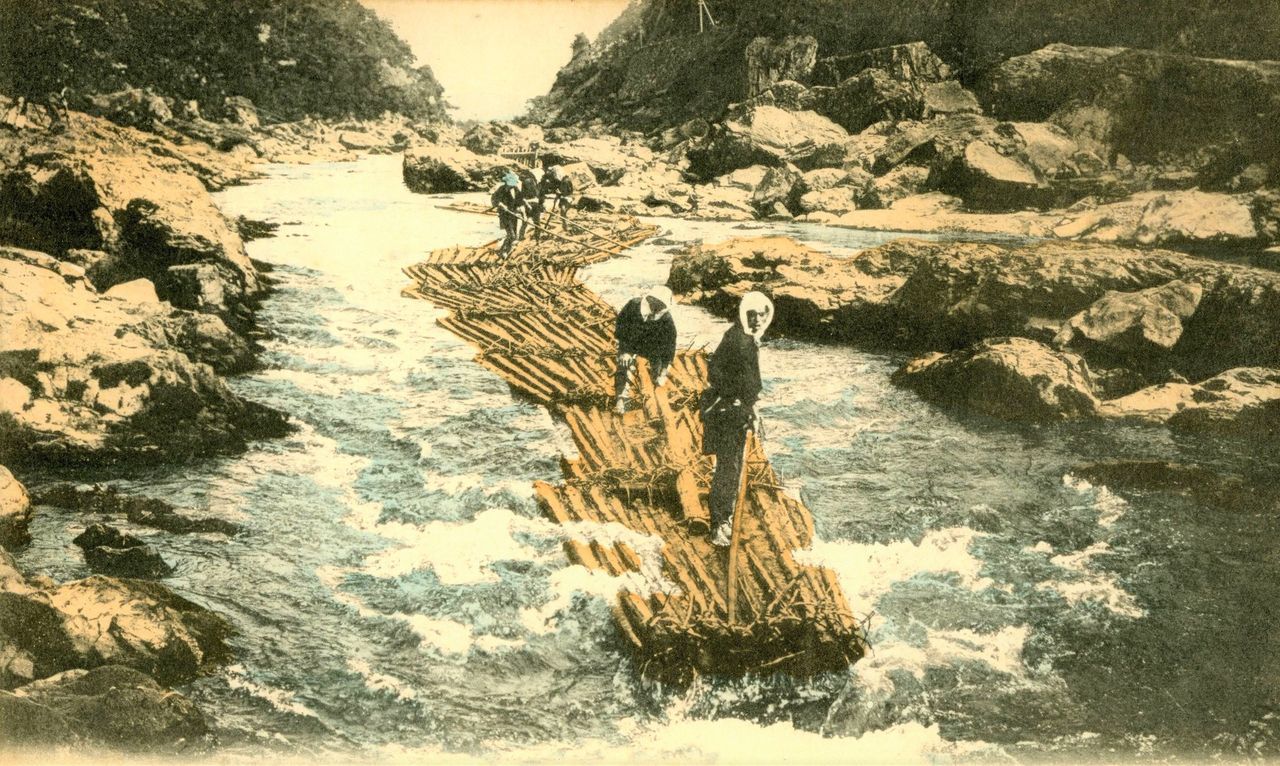
Raftsmen deliver lumber down the Hozugawa to Kyoto in the Meiji era (1868–1912). (Courtesy of the Hozugawa River Boat Ride Association)
New Ideas for an Old River
Given the depths of his industry’s history, Toyota laughs, his arrival as a young man in his twenties was not greeted with great warmth by the families that have been involved in river-running for generations. “I was long treated as an outsider,” he says; now, though, having worked his way up through the boat-poling ranks and marrying into a local family, he is firmly established in the Kameoka boating industry.
It may have been his outsider credentials that have let him bring new ideas into the industry. It is one that has changed as needed over the centuries, as he explains: from log-raft running starting in the Heian period (794–1185) to wooden boats, introduced around 450 years ago, which could carry rice and other produce from the rich farmlands of the Tanba region north of Kyoto to a hungry capital. The introduction of boats and the carving of channels for them by Suminokura Ryōi, whose family had made a fortune in shipping between Nagasaki and Ming China, allowed shipment of a greater variety of products, but required the boatsmen to walk back up the river afterward, pulling their boats along the waterway with strong ropes. The river is sculpted in carved stone and concrete in many locations, making it look less like a wild river for rafting and more like a theme-park ride in places. But the historical context makes it clear that this is a working waterway.
The river was the main channel of transport from Tanba to Kyoto until 1899, when the San’in train line opened, dealing a serious blow to the livelihoods of the rivermen. After World War II, when roads were carved through the mountains and trucks could carry cargo, shipping on the river was ended for good.
Boating tourism has a longer history here, though, as Toyota explains. “The Hozukyō, the valley through which the Hozugawa flows, has always been at the leading edge of the transportation industry, from the carving of its cargo channels more than 400 years ago to the tourism today. The British diplomat Ernest Satow spread the word about the thrill of traveling down the river toward the end of the 1800s, before whitewater rafting was a pastime in the countries of the West, and his reports enticed famous foreigners like Franz Ferdinand, then heir to the Austrian throne, who boated the river in 1893, and Crown Prince Edward of Britain, who visited in 1922.” Their accounts of the Hozugawa brought other foreigners to experience it, in the process helping to build it as a tourism destination for Japanese as well.
At the end of the 1980s the San’in line moved to a new, straighter course including more tunnels, and the Sagano line route fell into disuse. In 1991 the torokko train began operation on this line, bringing travelers from Kyoto to Kameoka, where they could board tour boats and float back to Arashiyama. This was the launch of the river’s modern era of tourism popularity.
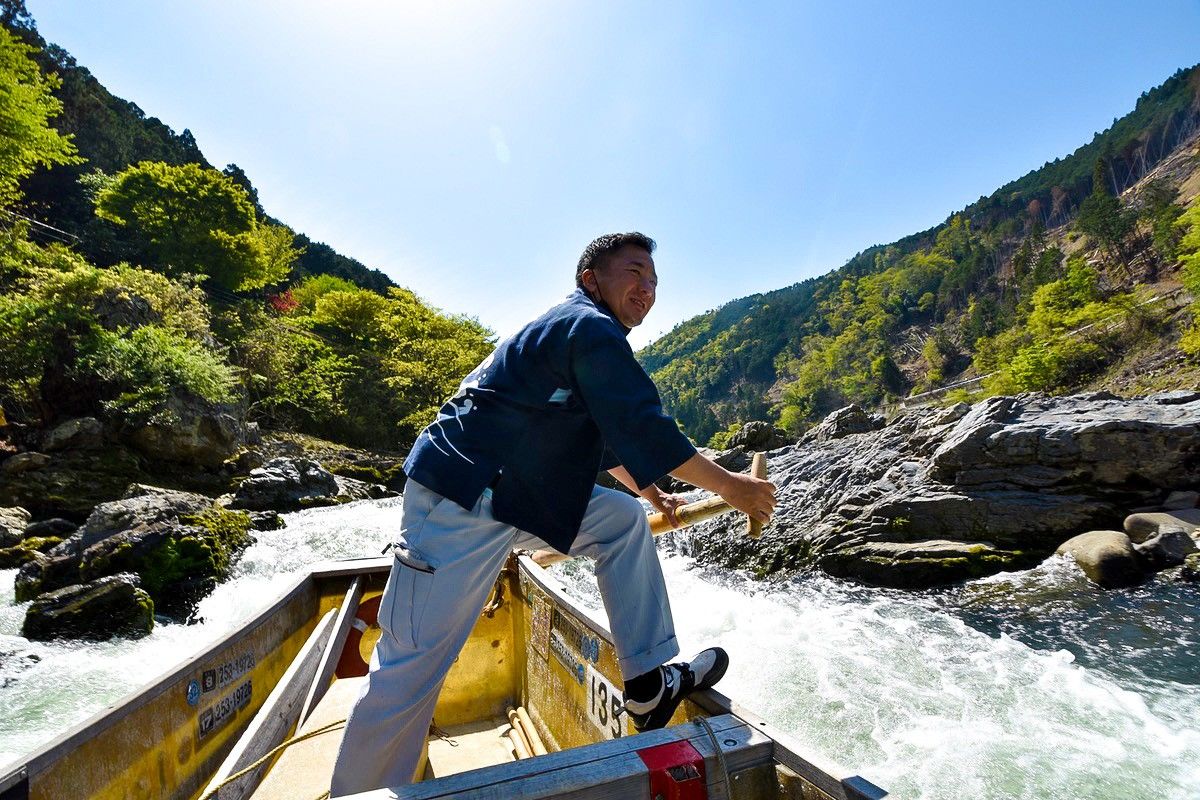
At aft, our pilot steers us through the rapids while two crewmembers in the bow use poles to keep us off of the rocks. (© Nippon.com)
This popularity is on hold now—we ride just one boat with a handful of other passengers, a far cry from the fleets of craft that launched to bring much larger crowds downstream just a few years ago. But Toyota and his team are looking for other ways to remain relevant and active. “We want to provide tourist experiences that illuminate what rivers actually mean to the Japanese,” he says. “When trains replaced boats as the main means of shipping, it was the end of a way of life for the boatsmen of the time. They had no safety net and their work evaporated overnight. Compared to what they went through, the pandemic seems like much less of a threat to us. But we have to buckle down. Kyoto remains high on the list of places where people want to visit after the disease dies down. We need to figure out what they want from their time here and reinforce their enjoyment.”
Ecotourism is a growing part of Toyota’s approach. His association’s rivermen have a closer relationship with the waters of the Hozugawa than anyone, and they see firsthand how pollution impacts the river, he notes. “Of course we’ve always been involved in picking trash out of the river, but we’ve also been trying to pin down where it comes from.” Since 2012 he has organized tests involving GPS-tagged floats, proving that trash making its way into the river in the Kameoka area can arrive in Osaka Bay in a matter of days. Another project is the creation of a “river trash map,” a database of contributed photos from residents throughout the river basin aimed at pinpointing spots where pollution occurs. Also in 2012, Kameoka became the first inland community to host the UN Marine Litter Summit, based in large part on Toyota’s work and the recognition that the garbage in the world’s oceans comes from people living inland. In 2018 the city became one of the first in Japan to ban the use of disposable plastic shopping bags.
Cooperating in the Hozugawa efforts is Funada Yukio, whose organization Nippon Junrei is involved in organizing river tours for university students that include trash collection while floating downstream. Eco-tours involving students and other visitors have been a regular fixture on the river since May 2021, helping to broaden the idea of what it means to enjoy a river experience in an era of environmental crisis.
Our ride is over in around two hours. We have floated some 16 kilometers downstream, about half of that distance as the crow flies, to the landing point near Arashiyama’s famed Togetsukyō bridge. In a calm stretch of the river after we clear the last of the whitewater, boats come alongside offering oden, fried squid, and other snacks along with drinks; the boatsmen enjoy soft drinks after a strenuous time poling us down the river, talking to us the whole time about the sights we see and the floods and other river events of recent years.
Temples Without the Crowds
After heading back into the city, we make our way to Terrace Kiyomizu, our hotel just down the hill from the temple Kiyomizudera. The neighborhood is quiet, with many of the souvenir and kimono rental shops already closed for the day, if they have not already been closed for some months during the tourist drought. The Gojōzaka lane and Sannenzaka staircase, ordinarily bustling with crowds, are deserted.
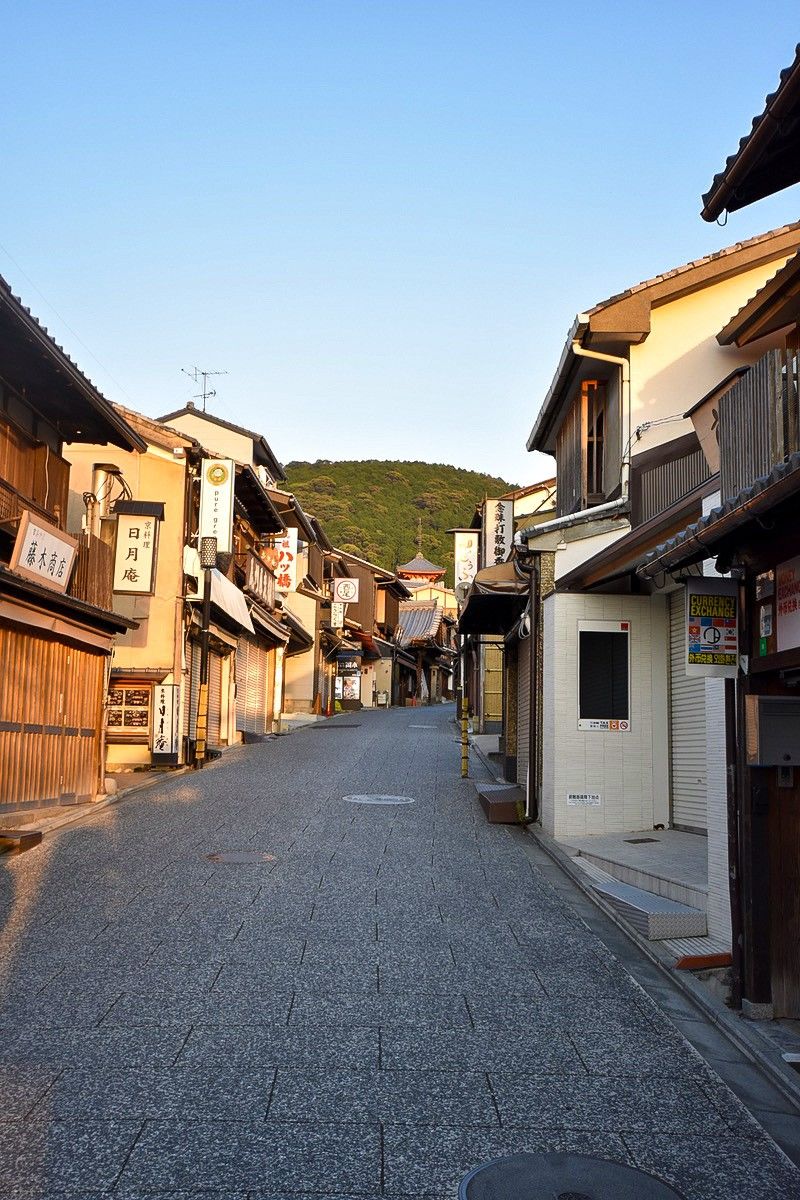
Walking up a deserted Gojōzaka toward the temple. (© Nippon.com)
Temple visiting hours are from six in the morning until six at night, but we are signed up for the Kurayami no Kiyomizudera tour—the temple after dark. The sun is setting as we mount the steps and stand in a place that most tourists see only alongside serious crowds.
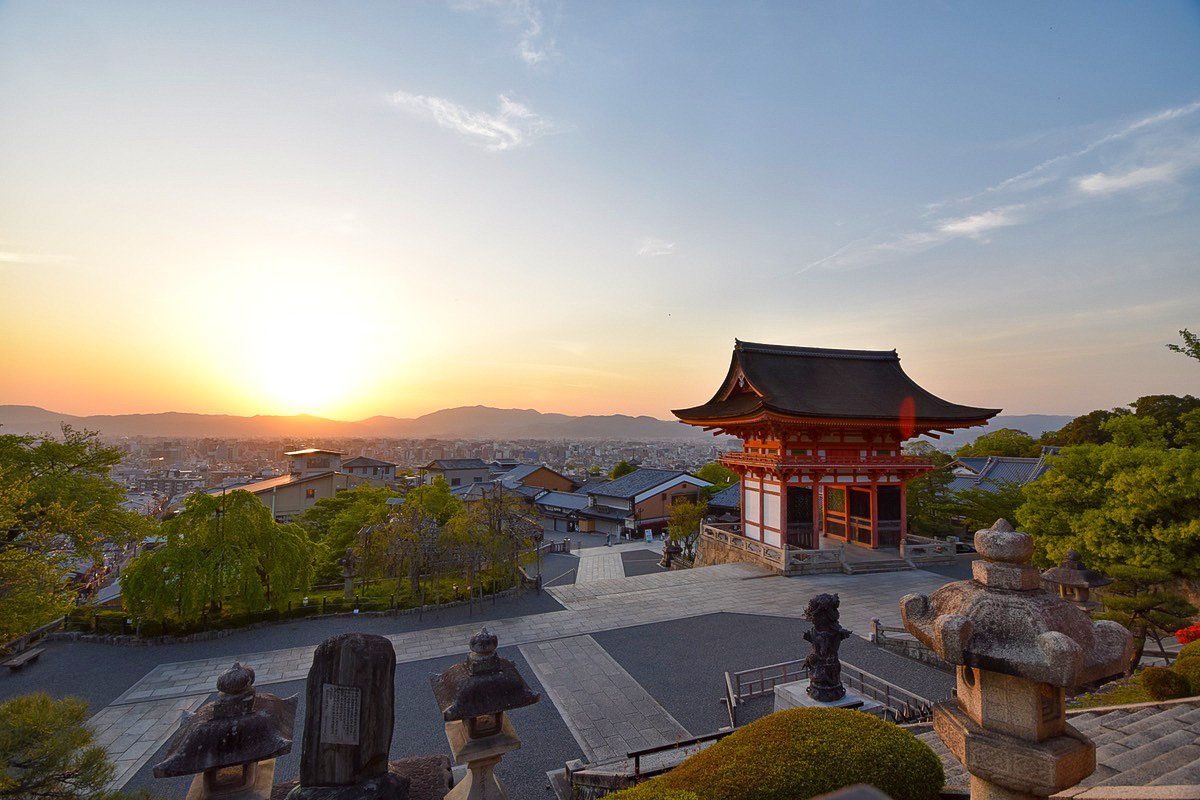
Sun sets on the Niōmon overlooking Kyoto. (© Nippon.com)
We enjoy this splendid view until the sun goes down behind the mountains we were boating through that morning and then head to the Kyōdō, or sutra hall, where we sit beneath the famous dragon painting on the ceiling and inscribe our prayers for the evening with the paper and calligraphic pens there. We take these back into the heart of the temple, passing through the gejin and naijin (the outer and inner sanctums) into the nainaijin—the innermost sanctum of the temple.
This Hondō main hall we stand in was rebuilt in the early seventeenth century atop a lowered stone floor typical of far older styles of temple architecture dating back to the Nara period (710–94), explains Mori Seigen, a key priest at Kiyomizudera and our guide for the evening. He says that the Kannon bodhisattva image we are now seeing, flanked by numerous statues of protecting deities, is not generally available for viewing; the temple has begun offering special tours like ours for devoted parishioners, letting them into a place most visitors cannot see. He also leads us along a narrow wooden hallway behind the Kannon hall, where we are as close as we can get to the hibutsu—the “hidden Buddha” statues that are the temple’s actual main objects of veneration, which are never displayed.
The hall itself is lit by traditional warōsoku candles, their tall flames glittering in reflection in the eyes of the protector statues that glare down at us as we listen to Mori’s explanation of the temple, its history, and the role of Kannon in the lives of the people. One by one, we take our prayers to the foot of the Kannon statue and offer our thoughts as we place the papers there and add a pinch of incense to the brazier at the center of the hall.
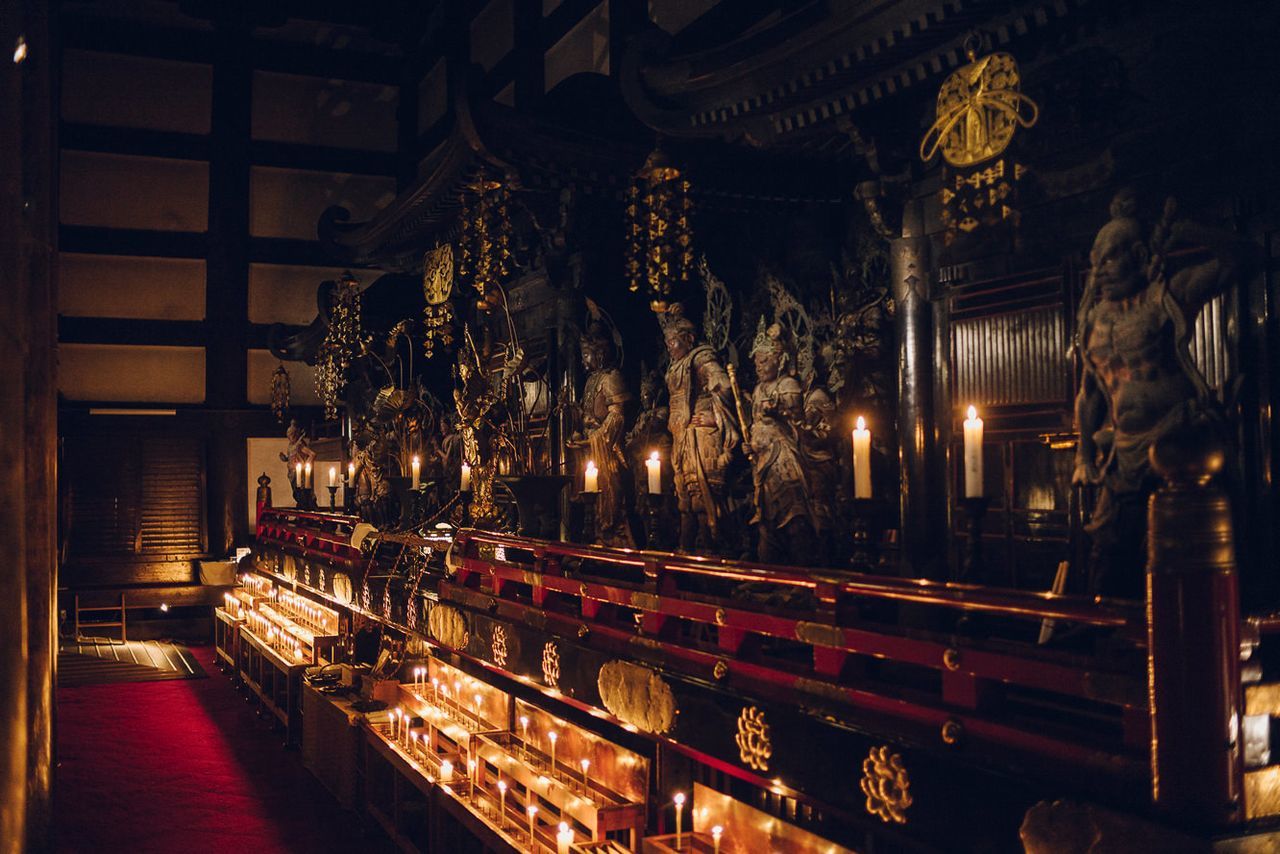
The nainaijin in the Hondō main hall, housing numerous images of Buddhist deities, is illuminated by candles alone. (Courtesy of Kiyomizudera)
Photography is not permitted in the nainaijin, but after we head back outside the cameras come out for the nighttime views of Kiyomizudera’s famous butai, or “stage,” the wooden platform overlooking the garden and waterfall to the south. Mori talks about the waterfall in particular as a symbol of the way the pandemic has changed things for his temple.
“This was originally very much a local temple—a place for residents of nearby neighborhoods to gather under the trees and enjoy the blossoms in spring, for instance. Overtourism in recent years has prevented people from enjoying it in that way. One man came to me recently with tears of joy in his eyes at being able to hear the waterfall from his home just down the hill—he had been unable to enjoy that sound during the day because of the tour buses parked in the nearby lot.” Another sound that temple visitors are enjoying once more in the relative quiet, he says, is the cries of the musasabi, giant Japanese flying squirrels, that nest in the woods above the temple.
Kiyomizudera has always been a place with strong connections to its visitors and nearby residents. Up through the early 1970s, says Mori, its gates were open 24 hours a day; an arson attempt in 1975 prompted the closure of its grounds from six each night. The night tours, he notes, are a way for people to once again get to know the different aspect the temple presents after hours, one that has not been available to visitors for nearly half a century.
Indeed, says Mori, the pandemic is something that gives us all time to rethink our relationships with one another and the world around us. His temple is exploring ways to connect with believers online, helping them to stay in touch with a place that is harder for many to visit from afar. “We are doing all right at Kiyomizudera,” he stresses. “This is a place of faith, not just a tourism destination, and we will always have people working to maintain their connections with us. But many shops and other businesses in Kyoto are having a very hard time, and we have to give thought to ways to help them through these days.”
Reinventing a Tourist Mecca
Mori’s comments match what I felt while in Kyoto. Residents have an easier time in their daily lives without extra millions of visitors crowding their streets, stores, and shrines. Traffic flows smoothly along the streets, making it easier to access the sights and enjoy them in a more leisurely way. But there is no denying that the city’s economy is weathering a terrible storm. Kyoto’s tax base was not particularly strong to begin with, say many locals, due to a lack of major businesses headquartered there and the sheer number of tax-exempt temples and other religious organizations that make the city such an alluring place to visit.
The city always managed to rebuild itself after the great fires in its past, though. Today it must search for new ways to attract smaller crowds of more dedicated visitors—through ecotourism, tours opening its best-known sights after dark, and other innovative means that will keep Kyoto on the top of many people’s must-visit places.
(Originally written in English. With thanks to Nippon Junrei and Funada Yukio for tour assistance. Banner photo: A night view of Kiyomizudera’s famed butai stage. © Nippon.com.)